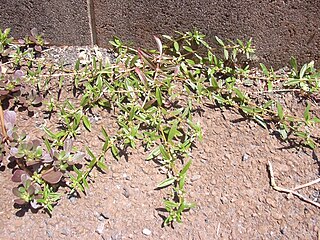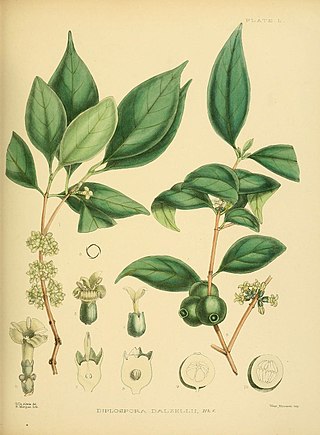
The Rubiaceae are a family of flowering plants, commonly known as the coffee, madder, or bedstraw family. It consists of terrestrial trees, shrubs, lianas, or herbs that are recognizable by simple, opposite leaves with interpetiolar stipules and sympetalous actinomorphic flowers. The family contains about 13,500 species in about 620 genera, which makes it the fourth-largest angiosperm family. Rubiaceae has a cosmopolitan distribution; however, the largest species diversity is concentrated in the tropics and subtropics. Economically important genera include Coffea, the source of coffee, Cinchona, the source of the antimalarial alkaloid quinine, ornamental cultivars, and historically some dye plants.

Oldenlandia is a genus of flowering plants in the family Rubiaceae. It is pantropical in distribution and has about 240 species. The type species for the genus is Oldenlandia corymbosa.

Canthium is a genus of flowering plants in the family Rubiaceae. They are shrubs and small trees. The leaves are deciduous and the stems are usually thorny.

Hoffmannia is a genus of flowering plants in the family Rubiaceae. They are distributed in Mexico, Central America, and South America.

Psydrax is a genus of flowering plants in the family Rubiaceae. It consists of trees, shrubs, and a few lianas in the paleotropics.

Pyrostria is a genus of dioecious flowering plants in the family Rubiaceae. Most of the species are endemic to Madagascar, others occur on islands in the western Indian Ocean, a few are found in continental Africa, and only six species occur in tropical Southeast Asia. The formerly recognized genus Leroya, containing two species endemic to Madagascar, L. madagascariensis and L. richardiae, was sunk into synonymy with Pyrostria.

Vanguerieae is a tribe of flowering plants in the family Rubiaceae and contains about 655 species in 30 genera. It is one of the most species-rich groups within the family and it is distributed across the Paleotropics.

Kadua is a genus of flowering plants in the family Rubiaceae. It comprises 29 species, all restricted to Polynesia. Twenty-two of these are endemic to the Hawaiian Islands. Some of the species are common at high elevation. Others are single-island endemics or very rare, and a few are probably extinct. Kadua affinis is widely distributed in Hawaii and is polymorphic. The type species for the genus is Kadua acuminata.
Anthorrhiza is a genus of myrmecophytic flowering plants in the family Rubiaceae. It is endemic to Papua New Guinea, including the Louisiade Archipelago. It is one of five ant-plant genera in the family Rubiaceae, the others being Hydnophytum, Myrmecodia, Myrmephytum, and Squamellaria.

Normandia is a monotypic genus of flowering plants in the family Rubiaceae. It was described by Joseph Dalton Hooker in 1872. The genus contains only one species, Normandia neocaledonica, which is endemic to New Caledonia. The genus is related to Coprosma and Nertera.
Bremeria is a genus of flowering plants in the family Rubiaceae. It was described in 2005 to accommodate all the Indian Ocean species formerly placed in Mussaenda, except the widespread Mussaenda arcuata. The genus is indigenous to Madagascar, Mauritius and Réunion, and is found in humid to subhumid evergreen forests.

Discospermum is a genus of flowering plants in the family Rubiaceae. The genus is found from India to the Philippines.
Thamnoldenlandia is a genus of plants in the Rubiaceae. It contains only one known species, Thamnoldenlandia ambovombensis, endemic to Madagascar.
Villaria is a genus of plants in the family Rubiaceae. It contains 5 accepted species, all endemic to the Philippines.

Kajewskiella is a genus of plants in the family Rubiaceae, endemic to the Solomon Islands.

Diplospora is a genus of flowering plants in the family Rubiaceae. The genus is found in tropical and subtropical Asia.
Durringtonia is a monotypic genus of flowering plants in the family Rubiaceae. The genus contains only one species, viz. Durringtonia paludosa, which is endemic to Australia.
Discospermum reyesii is a species of genus Discospermum, which are flowering plants in the family Rubiaceae. The species was described in 2018, and was found on Mount Lantoy, Cebu Province, Philippines. This species closely resemble that of D. whitfordii because of slightly similar leaf blades, leaf apices, and non-ribbed fruits. However, the species differs from D. whitfordii due to its smaller fruits with size of 1 - 1.2 cm, smaller seed size to 1 - 1.4 mm x 1.5 - 2.5 mm dimensions, 4 - 6 seeds per locule, whereas D. whitfordii have 2 - 2.7 cm fruit size, 5 - 6.5 mm x 5 - 6.5(7) mm seed size, and 5 - 12 seeds per locule.
Discospermum philippinensis is an endemic species of genus Discospermum, which are flowering plants in the family Rubiaceae. The species was described in 2015, and was found on Mt. Banahaw, Tayabas, Quezon Province, Philippines at an elevation of 623 m. This species closely resemble that of D. whitfordii because of its persistent calyx, and prominent disk below the fruit apex. However, the species differs from D. whitfordii due to leaf blades with a much larger dimensions, the leaf apex of which are acute to attenuate, the fruits of which are faintly ribbed, with the thin mesocarp that are smaller, and fewer seeds per locule.
Uncaria perrottetii, known locally in the Philippines as “sungay kalabaw”, is a species of liana in the family Rubiaceae.












